Configure Observe for Snowflake Application¶
Configure Observe for Snowflake App - Via UI¶
Snowflake for Observe native application needs some configuration before being able to send your Snowflake data to Observe.
Log into your Snowflake instance in Snowsight console
Change to the
ACCOUNTADMINroleNavigate to
Data Products\AppsClick
Observe for SnowflakeappClick
Settingsgear icon in top rightIf prompted, turn on
All eventsto be shared with application provider and clickSavebutton
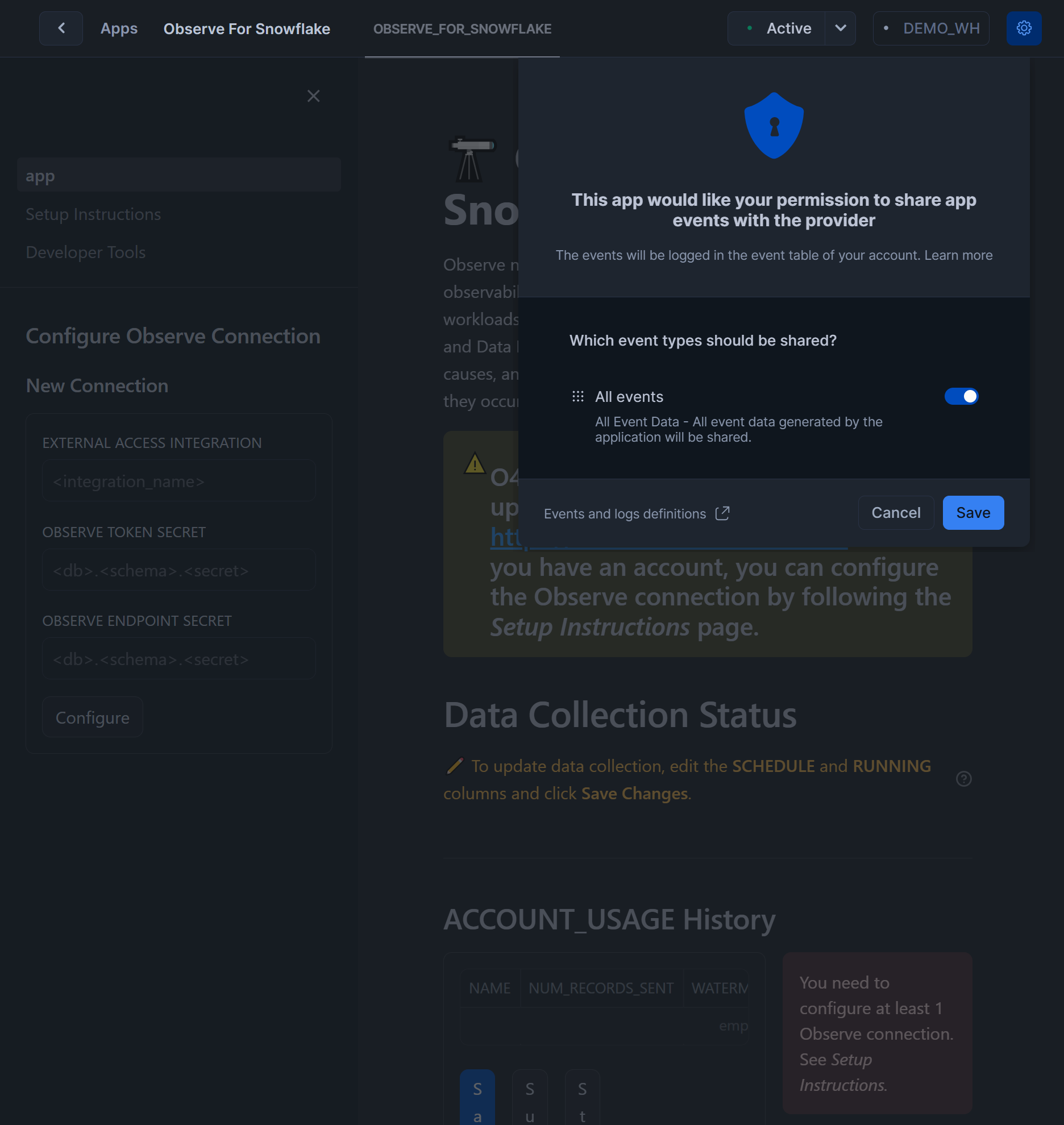
If prompted, grant requested
IMPORTED PRIVILEGES ON DATABASE SNOWFLAKE,EXECUTE TASKandEXECUTE MANAGED TASKprivileges by clickingGrant Privilegesbutton
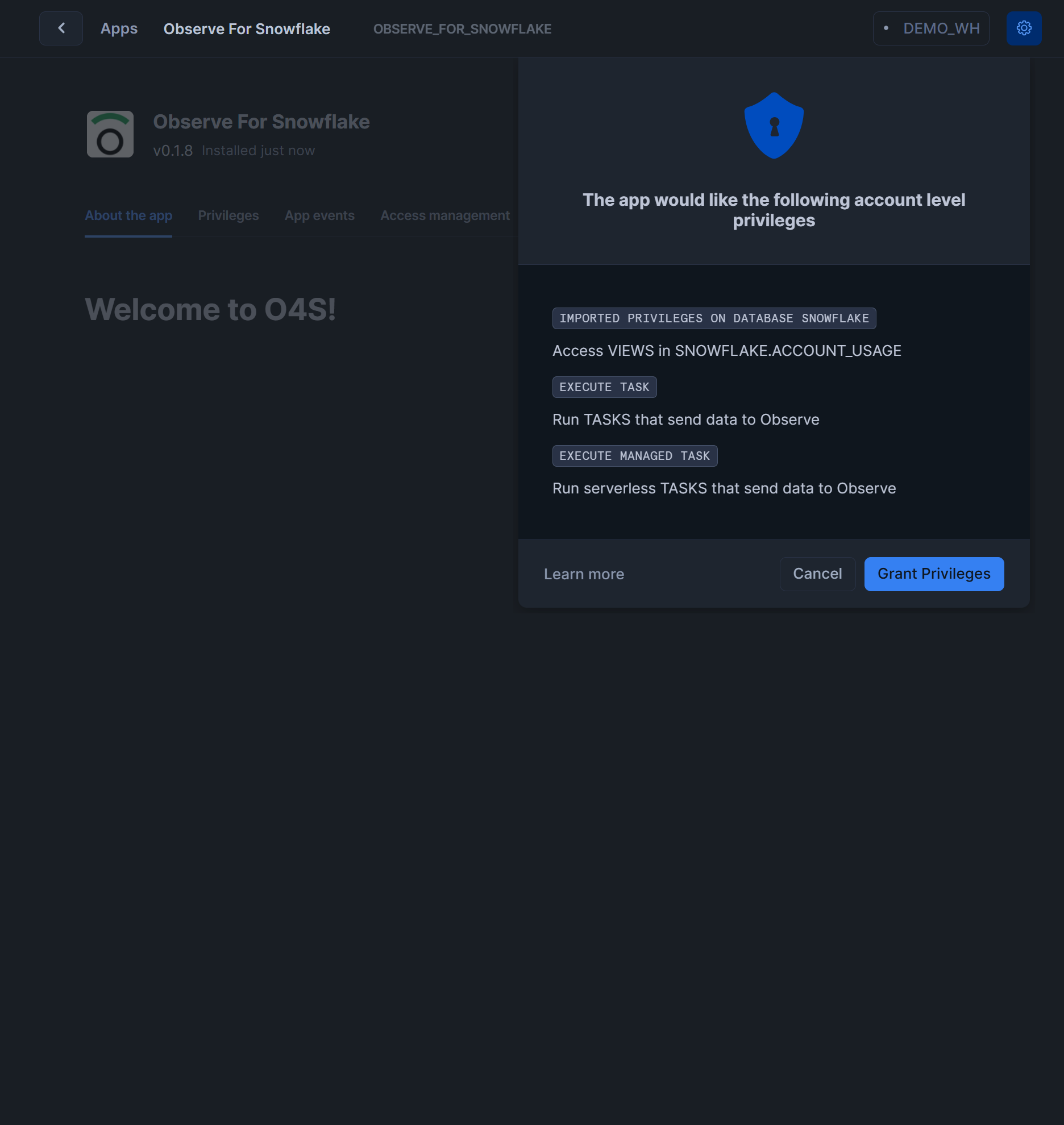
Click
PrivilegestabUnder
Object access privileges, clickAddbuttonSelect virtual warehouse you’ve created before (
O4S_WH)Click
Save
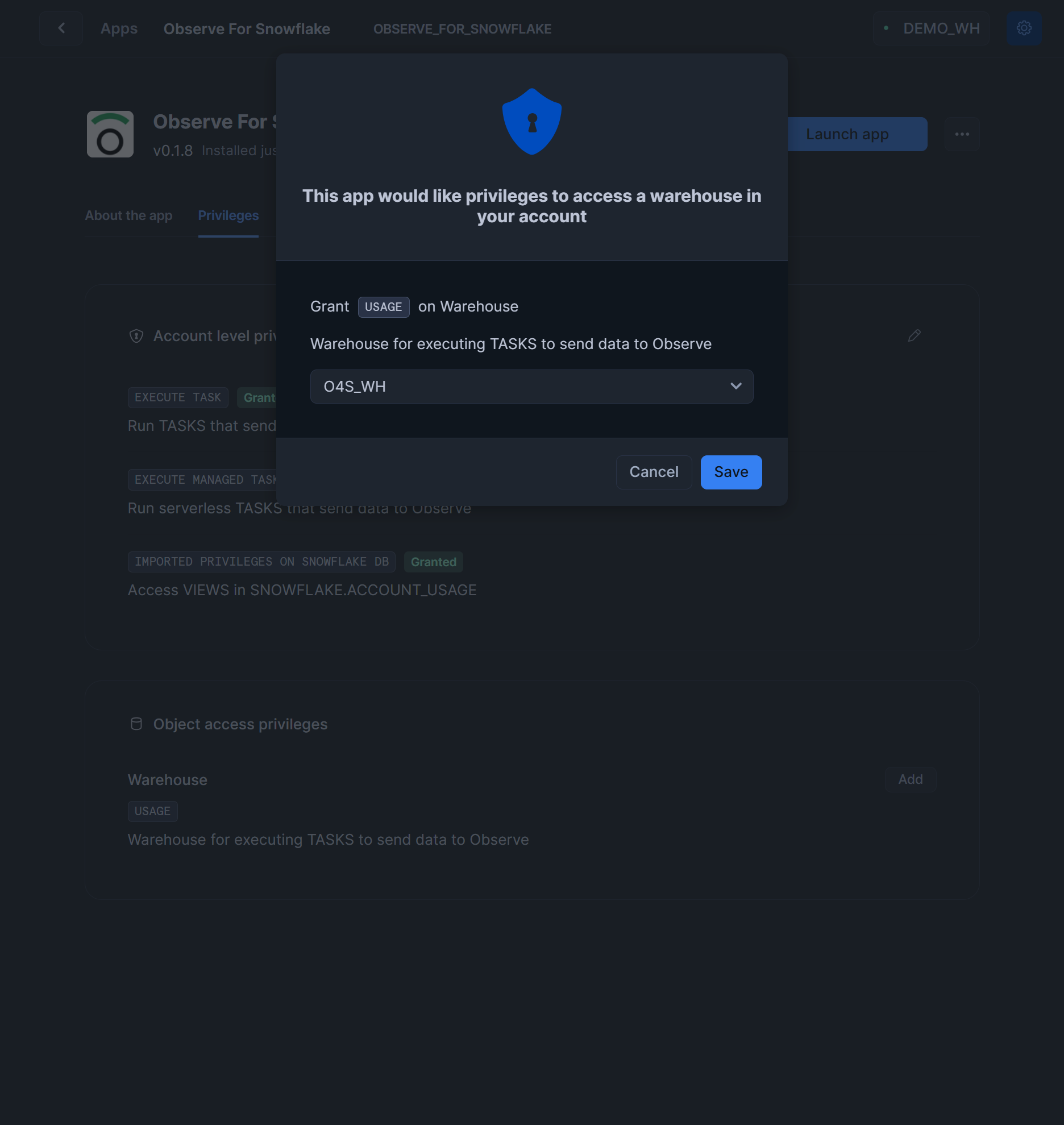
The final configuration on
Privilegestab should look like that:
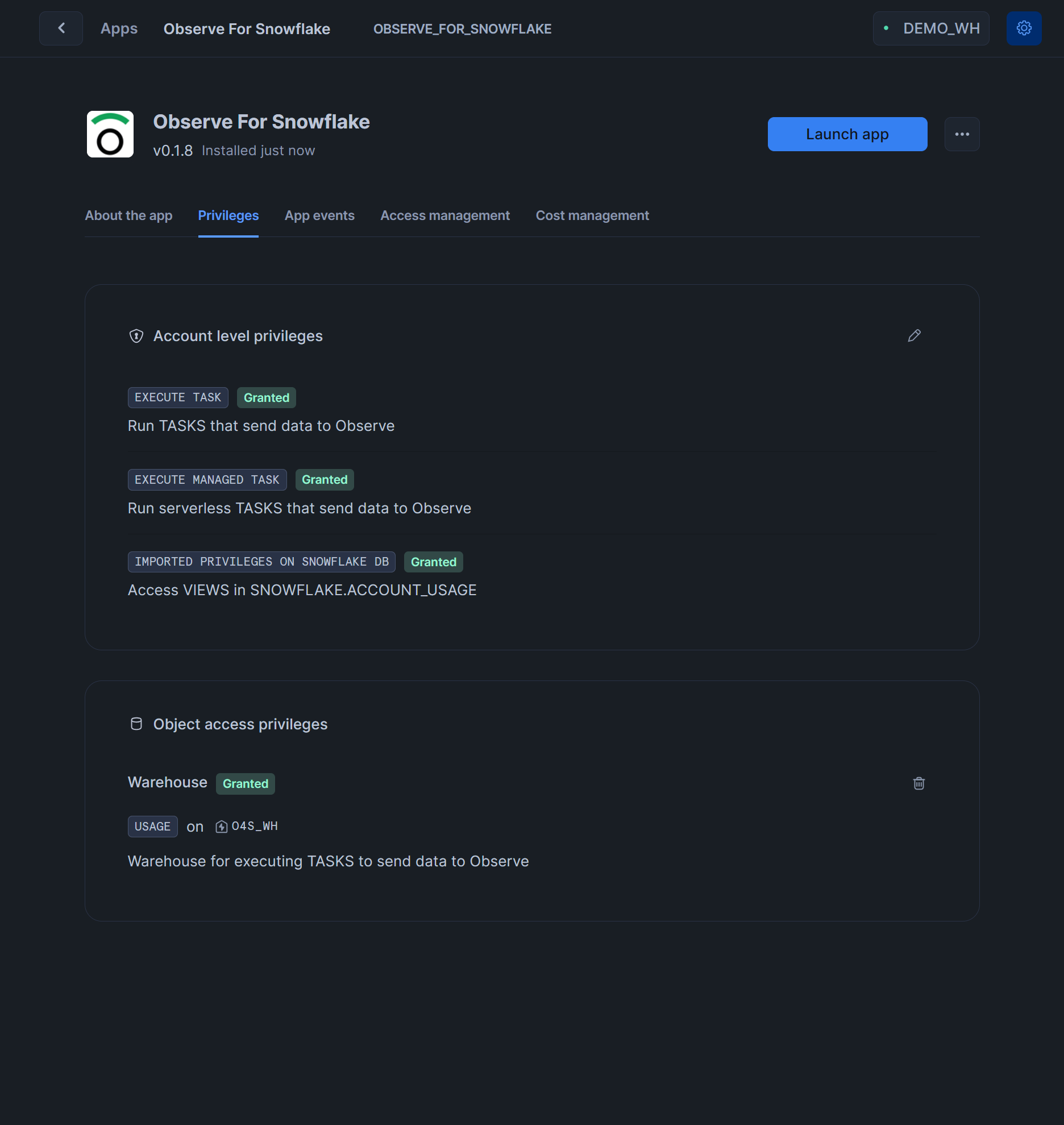
The final configuration on
App Eventstab should look like that:
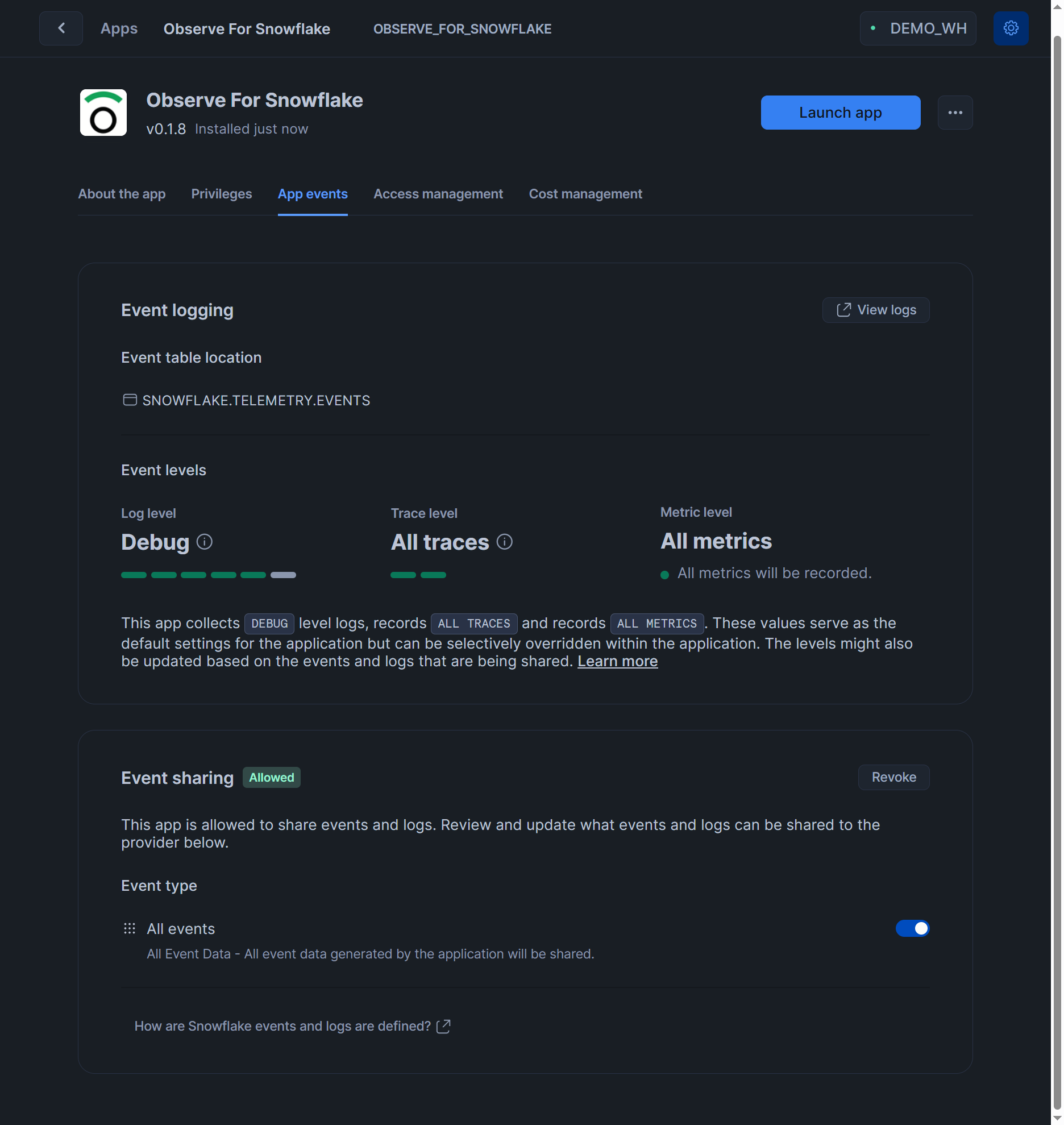
Click
Setup Instructionson left navigation barFollow instructions, which do require running some code in worksheet, which we document here
In another browser tab, log into your Snowflake instance in Snowsight console
Navigate to
Project\WorksheetsCreate new Worksheet and name is
o4s UI installRun step “2.1 Assume SYSADMIN Role for Object Creation”
USE ROLE SYSADMIN;
Run step “2.2 Create Database to Hold Secrets”, assuming database name to be
SEND_TO_OBSERVE
CREATE DATABASE IF NOT EXISTS SEND_TO_OBSERVE;
Run “2.3 Create Schema to Hold Secrets”, assuming schema to be
O4S
CREATE OR REPLACE SCHEMA SEND_TO_OBSERVE.O4S;
Run “2.4 Create Secrets”, putting in the value of the ingest token created in Observe earlier
CREATE OR REPLACE SECRET
<secret_db>.<secret_schema>.OBSERVE_TOKEN
TYPE = GENERIC_STRING
SECRET_STRING = 'ds<trimmed>:w7<trimmed>Hc';
Run “2.4 Create Secrets”, putting in the correct ingest endpoint for your account, typically
<youraccount######>.collect.observeinc.com
CREATE OR REPLACE SECRET
SEND_TO_OBSERVE.O4S.OBSERVE_ENDPOINT
TYPE = GENERIC_STRING
SECRET_STRING = '<youraccount######>.collect.observeinc.com';
Run “2.5 Create Network Rule” with the same ingest endpoint value from previous step
CREATE OR REPLACE NETWORK RULE
SEND_TO_OBSERVE.O4S.OBSERVE_INGEST_NETWORK_RULE
MODE = EGRESS
TYPE = HOST_PORT
VALUE_LIST = ('<youraccount######>.collect.observeinc.com');
Run “2.6 Create External Integration” to bind network rules and secrets to external access integration
USE ROLE ACCOUNTADMIN;
CREATE OR REPLACE EXTERNAL ACCESS INTEGRATION
OBSERVE_INGEST_ACCESS_INTEGRATION
ALLOWED_NETWORK_RULES = (SEND_TO_OBSERVE.O4S.OBSERVE_INGEST_NETWORK_RULE)
ALLOWED_AUTHENTICATION_SECRETS = (SEND_TO_OBSERVE.O4S.OBSERVE_TOKEN, SEND_TO_OBSERVE.O4S.OBSERVE_ENDPOINT)
ENABLED = TRUE;
Run “2.7 Grant Access to Secrets and External Integration” to allow
Observe for Snowflakeapplication access to the secrets and to external access integration
USE ROLE SECURITYADMIN;
GRANT USAGE ON DATABASE SEND_TO_OBSERVE TO APPLICATION OBSERVE_FOR_SNOWFLAKE;
GRANT USAGE ON SCHEMA SEND_TO_OBSERVE.O4S TO APPLICATION OBSERVE_FOR_SNOWFLAKE;
GRANT READ ON SECRET SEND_TO_OBSERVE.O4S.OBSERVE_TOKEN TO APPLICATION OBSERVE_FOR_SNOWFLAKE;
GRANT READ ON SECRET SEND_TO_OBSERVE.O4S.OBSERVE_ENDPOINT TO APPLICATION OBSERVE_FOR_SNOWFLAKE;
GRANT USAGE ON INTEGRATION OBSERVE_INGEST_ACCESS_INTEGRATION TO APPLICATION OBSERVE_FOR_SNOWFLAKE;
Run “3.1 Access to Default Event table” to allow access to default event table
USE ROLE SECURITYADMIN;
GRANT APPLICATION ROLE SNOWFLAKE.EVENTS_ADMIN TO APPLICATION OBSERVE_FOR_SNOWFLAKE;
Run “3.2 Access to Custom Event table” if you have a custom event table, replacing
<event_table_db>,<event_table_schema>,<event_table_name>with correct names
USE ROLE SECURITYADMIN;
GRANT USAGE ON DATABASE <event_table_db> TO APPLICATION OBSERVE_FOR_SNOWFLAKE;
GRANT USAGE ON SCHEMA <event_table_db>.<event_table_schema> TO APPLICATION OBSERVE_FOR_SNOWFLAKE;
GRANT SELECT ON TABLE <event_table_db>.<event_table_schema>.<event_table_name> TO APPLICATION OBSERVE_FOR_SNOWFLAKE;
Run “4. Modify the Custom Event Table to Enable CHANGE_TRACKING” if you have custom event table
USE ROLE SYSADMIN;
ALTER TABLE <event_table_db>.<event_table_schema>.<event_table_name> SET CHANGE_TRACKING = TRUE;
Click
apptab on the navigation to switch back to main screenin
Configure Observe Connectionon the left, specify the previously created objects:OBSERVE_INGEST_ACCESS_INTEGRATIONfor EXTERNAL ACCESS INTEGRATIONSEND_TO_OBSERVE.O4S.OBSERVE_TOKENfor OBSERVE TOKEN SECRETSEND_TO_OBSERVE.O4S.OBSERVE_ENDPOINTfor OBSERVE ENDPOINT SECRET
Click Configure
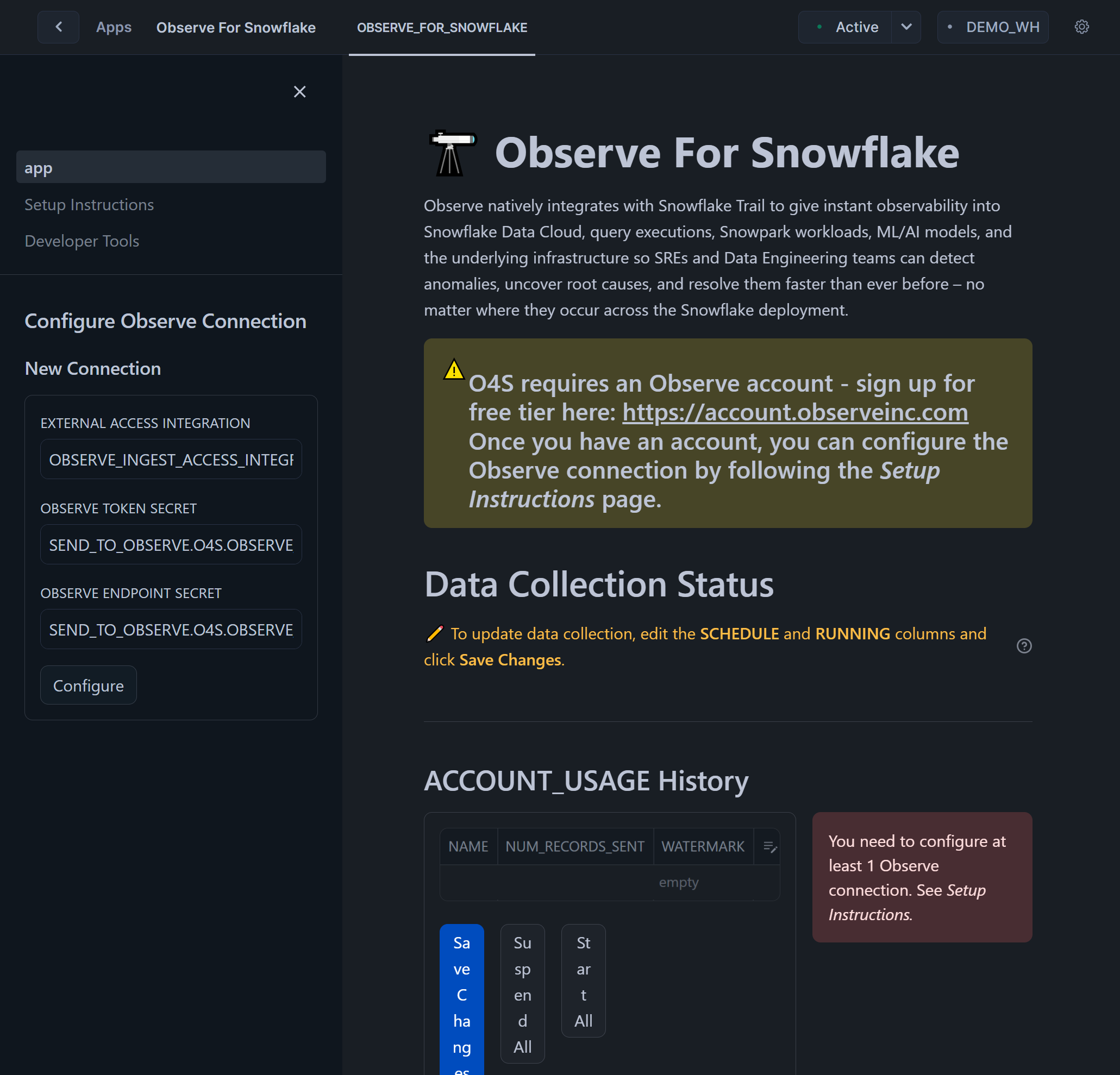
Results of successful configuration should look like that
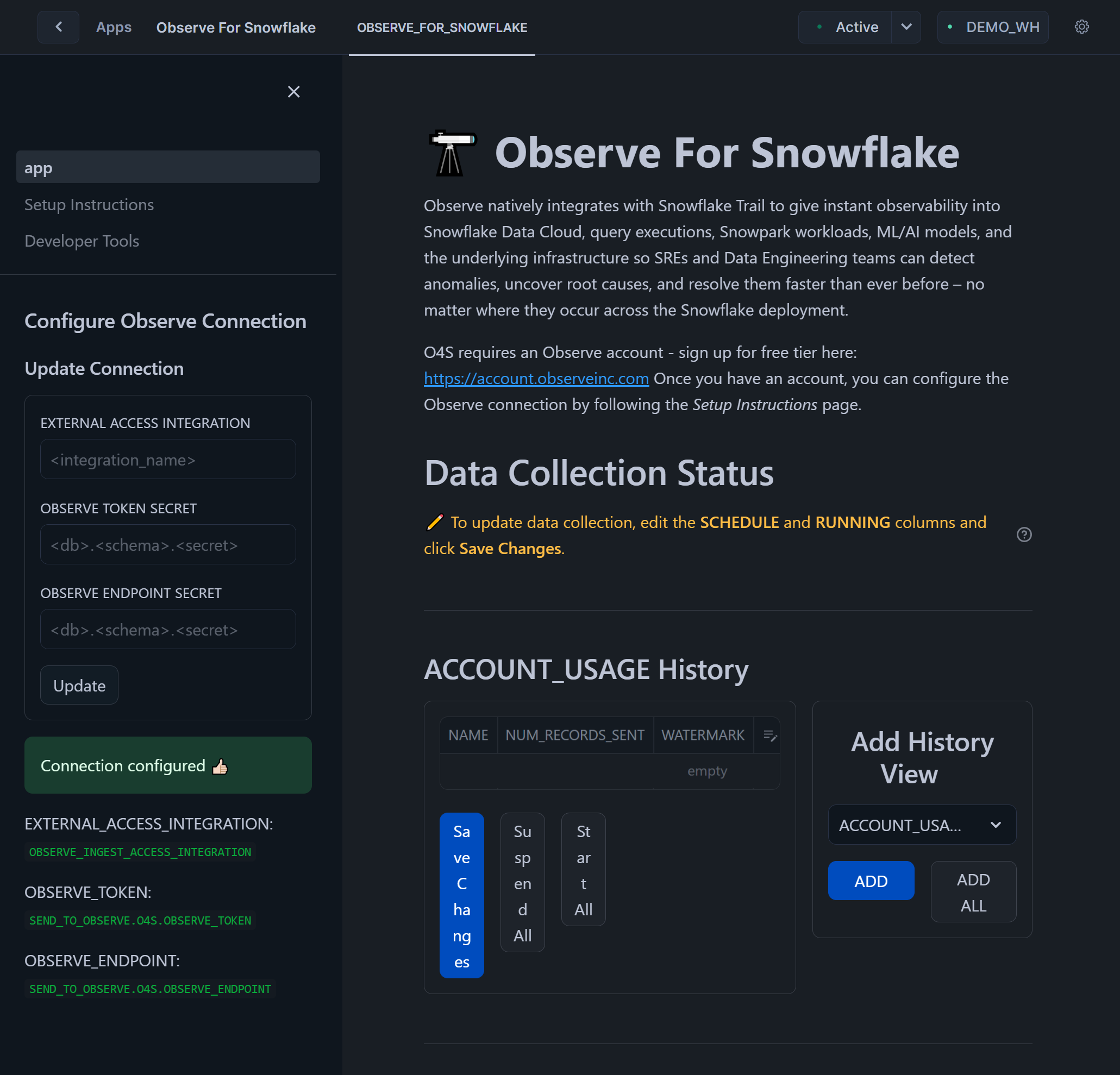
Configure Observe for Snowflake App - Developer Tools¶
O4S provides a Developer Tools area that you can reach via the left-nav. Developer tools provides a UI to interact with the data collection tasks that O4S runs in your Snowflake account. These are advanced configuration options that you can use to fine tune and troubleshoot the behavior of O4S.
Consult with Observe support before using these tools.
TASK Details¶
This provides an overview of the various data collection task names, schedules and states. The NAME column can be used to target changes to task properties.
Alter TASK Properties¶
This provides a mechanism to change the configuration for task suspensions, based on error responses from the Observe ingest endpoint (default is 0, which will be infinite retries). It also allows you to set the timeout for task execution (default is 24 hours or 86400000 milliseconds).
Clear STREAM¶
Clearing the stream is only intended in emergency cases, and will cause all current data to be clears and unrecoverable. Consult with Observe support if you believe you need to clear the O4S stream.
Configure Observe for Snowflake App - Via Console¶
Log into your Snowflake instance in Snowsight console
Navigate to
Project\WorksheetsUse previously created
o4s scripted installworksheetRun:
Replace
<secret_db>with your preferred database name. We recommendSEND_TO_OBSERVEReplace
<secret_schema>with your preferred database name. We recommendO4SReplace
<token_string>with the value of the ingest token created in Observe earlierReplace
<endpoint_string>with the correct ingest endpoint for your account, typically<youraccount######>.collect.observeinc.comIf you have a custom event table, replace
<event_table_db>,<event_table_schema>,<event_table_name>with correct names and uncomment relevant sections to grant permission and turn on CDC stream support on itIf you have a custom table or a view, replace
<table_or_view_db>,<table_or_view_schema>,<table_or_view_name>with correct names and uncomment relevant sections to grant permission and turn on CDC stream support on it
--------------------------------------------------------------------------------
-- [ Streamlit UI ]
-- Step 2: Accept event sharing to provider
-- UI in Streamlit app does this if you accept the popup
--------------------------------------------------------------------------------
USE ROLE ACCOUNTADMIN;
ALTER APPLICATION OBSERVE_FOR_SNOWFLAKE SET AUTHORIZE_TELEMETRY_EVENT_SHARING=true;
ALTER APPLICATION OBSERVE_FOR_SNOWFLAKE SET SHARED TELEMETRY EVENTS ('SNOWFLAKE$ALL');
--------------------------------------------------------------------------------
-- [ Streamlit UI ]
-- Step 3: Grant the app access to ACCOUNT_USAGE views and TASK execution
-- UI in Streamlit app does this if you accept the popup
--------------------------------------------------------------------------------
USE ROLE ACCOUNTADMIN;
GRANT IMPORTED PRIVILEGES ON DATABASE SNOWFLAKE TO APPLICATION OBSERVE_FOR_SNOWFLAKE;
GRANT EXECUTE TASK ON ACCOUNT TO APPLICATION OBSERVE_FOR_SNOWFLAKE;
GRANT EXECUTE MANAGED TASK ON ACCOUNT TO APPLICATION OBSERVE_FOR_SNOWFLAKE;
--------------------------------------------------------------------------------
-- [ manual ]
-- Step 4: Create secrets, network rule, and external access integration
-- variables to replace below: <secret_db>, <secret_schema>, <token_string>, <endpoint_string>
--------------------------------------------------------------------------------
-- Assume a regular SYSADMIN role for object creation
USE ROLE SYSADMIN;
-- Create database to hold secrets. For example, SEND_TO_OBSERVE
CREATE DATABASE IF NOT EXISTS <secret_db>;
-- Create Schema to hold secrets. for example, SEND_TO_OBSERVE.O4S
CREATE OR REPLACE SCHEMA <secret_db>.<secret_schema>;
-- <token_string> looks like ds1u2GzisdVhTjFNulN7:<trimmed>...
CREATE OR REPLACE SECRET
<secret_db>.<secret_schema>.OBSERVE_TOKEN
TYPE = GENERIC_STRING
SECRET_STRING = '<token_string>';
-- <endpoint_string> looks like 152194748953.collect.observe-eng.com or 141741533462.collect.observeinc.com in production
CREATE OR REPLACE SECRET
<secret_db>.<secret_schema>.OBSERVE_ENDPOINT
TYPE = GENERIC_STRING
SECRET_STRING = '<endpoint_string>';
CREATE OR REPLACE NETWORK RULE
<secret_db>.<secret_schema>.OBSERVE_INGEST_NETWORK_RULE
MODE = EGRESS
TYPE = HOST_PORT
VALUE_LIST = ('<endpoint_string>');
-- Assume a high privileges ACCOUNTADMIN role for external integration creation because that's the only way it could happen
USE ROLE ACCOUNTADMIN;
-- This allows Snowflake to talk to the Observe via network rule and use the secrets
CREATE OR REPLACE EXTERNAL ACCESS INTEGRATION
OBSERVE_INGEST_ACCESS_INTEGRATION
ALLOWED_NETWORK_RULES = (<secret_db>.<secret_schema>.OBSERVE_INGEST_NETWORK_RULE)
ALLOWED_AUTHENTICATION_SECRETS = (<secret_db>.<secret_schema>.OBSERVE_TOKEN, <secret_db>.<secret_schema>.OBSERVE_ENDPOINT)
ENABLED = TRUE;
-- Assume a SECURITYADMIN role for grants per best practices
USE ROLE SECURITYADMIN;
-- Grants access to the database holding secrets and to the external access integration
GRANT USAGE ON DATABASE <secret_db> TO APPLICATION OBSERVE_FOR_SNOWFLAKE;
GRANT USAGE ON SCHEMA <secret_db>.<secret_schema> TO APPLICATION OBSERVE_FOR_SNOWFLAKE;
GRANT READ ON SECRET <secret_db>.<secret_schema>.OBSERVE_TOKEN TO APPLICATION OBSERVE_FOR_SNOWFLAKE;
GRANT READ ON SECRET <secret_db>.<secret_schema>.OBSERVE_ENDPOINT TO APPLICATION OBSERVE_FOR_SNOWFLAKE;
GRANT USAGE ON INTEGRATION OBSERVE_INGEST_ACCESS_INTEGRATION TO APPLICATION OBSERVE_FOR_SNOWFLAKE;
--------------------------------------------------------------------------------
-- [ manual ]
-- Step 5: Grant the app access to specific event table.
-- Note that Snowflake now provides a Default Event Table (SNOWFLAKE.TELEMETRY.EVENTS), which you can read more about here:
-- https://docs.snowflake.com/en/developer-guide/logging-tracing/event-table-setting-up#default-event-table
-- You can use this if you do not already have a custom Event Table configured.
-- variables to replace below: <event_table_db>, <event_table_schema>, <event_table_name>
--------------------------------------------------------------------------------
USE ROLE SECURITYADMIN;
-- Grant permissions to read default event table SNOWFLAKE.TELEMETRY.EVENTS
GRANT APPLICATION ROLE SNOWFLAKE.EVENTS_ADMIN TO APPLICATION OBSERVE_FOR_SNOWFLAKE;
-- Grant permissions to read non-default event table of your choice
-- GRANT USAGE ON DATABASE <event_table_db> TO APPLICATION OBSERVE_FOR_SNOWFLAKE;
-- GRANT USAGE ON SCHEMA <event_table_db>.<event_table_schema> TO APPLICATION OBSERVE_FOR_SNOWFLAKE;
-- GRANT SELECT ON TABLE <event_table_db>.<event_table_schema>.<event_table_name> TO APPLICATION OBSERVE_FOR_SNOWFLAKE;
USE ROLE SYSADMIN;
-- Change your custom event table to support change tracking so we can create a CDC stream on it
-- ALTER TABLE <event_table_db>.<event_table_schema>.<event_table_name> SET CHANGE_TRACKING=TRUE;
--------------------------------------------------------------------------------
-- [ manual ]
-- Step 6: Grant the app access to any custom table and event.
-- -- variables to replace below: <table_or_view_db>, <table_or_view_schema>, <table_or_view_name>
--------------------------------------------------------------------------------
USE ROLE SECURITYADMIN;
-- Grant permissions to read and use the custom table or view
-- GRANT USAGE ON DATABASE <table_or_view_db> TO APPLICATION OBSERVE_FOR_SNOWFLAKE;
-- GRANT USAGE ON SCHEMA <table_or_view_db>.<table_or_view_schema> TO APPLICATION OBSERVE_FOR_SNOWFLAKE;
-- Choose the right statement based on the object type
-- GRANT SELECT ON TABLE <table_or_view_db>.<table_or_view_schema>.<table_or_view_name> TO APPLICATION OBSERVE_FOR_SNOWFLAKE;
-- GRANT SELECT ON VIEW <table_or_view_db>.<table_or_view_schema>.<table_or_view_name> TO APPLICATION OBSERVE_FOR_SNOWFLAKE;
USE ROLE SYSADMIN;
-- Change your custom table or view to support change tracking so we can create a CDC stream on it
-- Choose the right statement based on the object type
-- ALTER TABLE <table_or_view_db>.<table_or_view_schema>.<table_or_view_name> SET CHANGE_TRACKING = TRUE;
-- ALTER VIEW <table_or_view_db>.<table_or_view_schema>.<table_or_view_name> SET CHANGE_TRACKING = TRUE;
--------------------------------------------------------------------------------
-- [ Streamlit UI ]
-- Step 7: Grant access to a virtual warehouse in the account.
-- variables to replace below: <warehouse_name>
-- UI in Streamlit app does this if you accept a popup
--------------------------------------------------------------------------------
USE ROLE ACCOUNTADMIN;
USE APPLICATION OBSERVE_FOR_SNOWFLAKE;
CALL OBSERVE_FOR_SNOWFLAKE.CONFIG.REGISTER_SINGLE_REFERENCE(
'warehouse' , 'ADD', SYSTEM$REFERENCE('WAREHOUSE', '<warehouse_name>', 'PERSISTENT', 'USAGE'));
--------------------------------------------------------------------------------
-- [ Streamlit UI ]
-- Step 8: Configure the connection to send to observe via external access integration
-- variables to replace below: <secret_db>, <secret_schema>, <token_string>, <endpoint_string>
--------------------------------------------------------------------------------
USE ROLE ACCOUNTADMIN;
USE APPLICATION OBSERVE_FOR_SNOWFLAKE;
CALL OBSERVE_FOR_SNOWFLAKE.PUBLIC.PROVISION_CONNECTOR(
PARSE_JSON('{"observe_token": "<secret_db>.<secret_schema>.OBSERVE_TOKEN",
"observe_endpoint": "<secret_db>.<secret_schema>.OBSERVE_ENDPOINT",
"external_access_integration": "OBSERVE_INGEST_ACCESS_INTEGRATION"}')
);